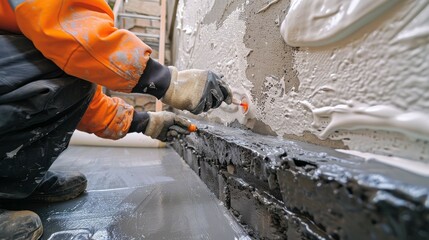Foundation Repair Greensboro NC involves installing supports under your home to lift sunken areas. The supports can be piers (also known as pilings) or concrete piles.
This is a major project and can take several weeks depending on the method used. It may also be disruptive to the home. This is why choosing the right contractor is crucial for the success of the repairs.
When homeowners notice cracks in their foundation, they usually react in one of two ways. They either panic that their house is about to fall apart or they shrug them off as a normal sign of settling. Both reactions are incorrect; if the cracks are wider than hairline and are expanding, it’s time to contact a professional for a thorough assessment and possible repairs.
Widening cracks in the foundation indicate that water or soil is exerting pressure on concrete walls. This can happen due to changing weather conditions or if the house was built on expansive soil that expands when it gets wet and contracts when it dries. These forces can put stress on concrete, creating hairline cracks that are likely to grow into more significant issues over time if they’re not addressed.
Other causes of foundation cracking can include soil erosion, excavation work too close to the home, and changes in the moisture content of soil around the house. Heavy rains, melting snow, and irrigation systems are also common causes of foundation damage because they can lead to puddles or pools of water under the house. These puddles can cause the foundation to sink and create voids that eventually lead to structural problems like sagging support beams.
If the cracks are narrower than hairline, a waterproof masonry sealant can be used to fill them. To make this type of repair, remove the dirt from the crack and the area around it, clean the concrete, and then use a caulking gun to apply the sealant directly into the crack. If the crack is too large to apply a sealant, injection ports can be drilled into the sides of the foundation and filled with epoxy or urethane. This allows the crack to be filled precisely and with a more durable material than caulking.
Leaky Pipes
Many people don’t realise that the pipes within their foundations are one of the most important structural elements of their homes. That’s why it’s essential to ensure they are well-maintained and regularly checked for damage, especially if you’ve had recent foundation work carried out on your home. Leaking pipes can compromise the integrity of a foundation and significantly increase the amount of water that enters a building.
Typically, pipe leaks in foundations occur in the water lines that run in and out of the home to connect to the main water and sewer systems. These pipes are buried underneath the concrete slab of a foundation and can get pinhole leaks, cracks or corrode over time. Since they’re the primary water lines into and out of the home, they need to be in good condition to prevent serious damage. If a leak occurs in these pipes, they can saturate the soil around the foundation and cause it to shift.
This is particularly true for expansive soils like clay that swell when they’re saturated with water. Over time, the shifted soil can put pressure on the foundation and cause it to crack.
Another cause of foundation leaks is abrasion. Copper pipe tends to wear thin over time and spring a leak as it rubs against the concrete or rock in the soil. If the abrasion isn’t remedied quickly, it can lead to a severe leak in the foundation.
If you have a leaking foundation, it’s vital to contact a professional plumber as soon as possible. They’ll need to locate the source of the leak and then break through the concrete to remove it and replace it with new piping. The sooner you can catch a foundation leak, the less expensive it’ll be to repair the damage caused.
Water Infiltration
Water infiltration is the underlying cause of many residential foundation issues. It can result in mold growth, deterioration of organic construction materials, structural gaps and cracks, and other significant damage both above and below ground. When unchecked, it can also lead to soil erosion and shifts that can damage foundations. It can even eat through concrete, leaving a hollow core and compromising the integrity of the home’s structure. Several factors can influence how fast water infiltrates the foundation, including drainage, soil slope, and hydrostatic pressure.
Effective solutions like basement waterproofing can help to mitigate water intrusion issues. The key is addressing issues early on, before they get out of hand. Regular inspections can catch problems and allow for early intervention, saving time and money.
For example, minor cracks can be filled with epoxy injections to prevent water seepage. Additionally, grading the property so that it slopes away from the foundation can help to keep surface waters from pooling near the foundation and ejecting hydrostatic pressure. French drain systems and sump pumps are additional effective solutions for areas prone to flooding.
Some repair methods can be DIY, but complex issues should always be addressed by professionals. Professionals have the equipment and knowledge to ensure that the problem is resolved, and often offer warranties or guarantees on their work. These are important peace of mind for homeowners and can give them confidence that the repairs will last.
Uneven Floors
While sagging floors might seem like a quirk or part of an old house’s character, they are often symptomatic of larger structural issues. Uneven floor areas can result from foundation settlement, water damage in crawl spaces, and more. Ignoring these signs of structural damage will only cause the problems to get worse.
Foundation settlement occurs when the soil under certain parts of the foundation shifts and sinks lower than other parts of the foundation. This uneven settling affects the floors above it, causing them to become uneven as well.
Other causes of uneven floors include excessive moisture, which can warp and weaken materials including wood beams and sub-flooring. Excessive moisture may come from a leaky pipe hidden within walls or from groundwater pooling around and beneath the foundation. In some regions, clay-rich soils can also erode over time, which can affect the foundation and the materials underneath it.
Moisture damage is especially dangerous for wood-framed structures like foundations and floor joists, which can rot or weaken over time if they are exposed to excess moisture. Moisture can also damage the foundation itself by causing it to sink or crack.
Fortunately, if your home’s floor joists and beams are sagging due to excess moisture or foundation damage, there are several effective solutions. A professional will be able to diagnose the problem and recommend the most effective repair method. For example, if the foundation has settled unevenly due to soil problems, push and helical piers can be installed to connect the foundation to stable strata or bedrock and lift it back to its original position, leveling the floors in the process. If your floor joists are sagging because they lack adequate support, crawl space jacks can be used to lift and stabilize them.
Sticking Doors
Sticking doors are a common issue caused by shifting foundations. When a foundation sinks into incompetent soil, it exerts pressure on the entire structure and shifts everything attached to it. The door frames in these structures are particularly prone to settling, which can cause them to warp and become stuck.
Fortunately, there are two common ways to fix these problems. One involves sanding and planing the frames to get them back into square. Another involves shimmying the frame, which helps to relevel crooked doorframes and allow them to open and close smoothly. However, neither of these solutions address the underlying problem that causes your doorframes to settle.
If you find that your doorframes are sticking due to a shifting foundation, it’s important to consult with an experienced professional. They’ll perform a full inspection to determine the root cause of your issue, which may require a different type of repair than simply adjusting the doors and window frames.
Another common reason for sticky doors is excessive humidity. This is particularly common in areas with high rainfall, but can also happen during the summer if a home is located on a swampy ground. If you suspect that this is the case, running a dehumidifier may help to resolve the issue.
The most serious cause of a sticking door is foundation settlement, which can affect both slab and crawl space foundations. As the foundation sinks into the soil, it exerts stress on the entire structure and shifts everything attached, including the door frames. If you’re experiencing this issue, a permanent solution is available through steel pier underpinning. This underground stilt system drives helical and push piers to competent, load-bearing soil, lifting the foundation to reclaim the doorframes and alleviating the stresses that were forcing them to shift.



